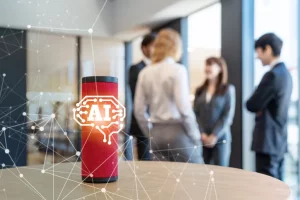Voice recognition, commonly known as speaker recognition, is a technology that enables machines to receive and interpret spoken commands. This innovation allows users to interact with devices using their voice, simplifying tasks like dictation, setting reminders, and controlling smart devices. With the rise of artificial intelligence (AI) and intelligent assistants such as Amazon’s Alexa and
Voice recognition, commonly known as speaker recognition, is a technology that enables machines to receive and interpret spoken commands. This innovation allows users to interact with devices using their voice, simplifying tasks like dictation, setting reminders, and controlling smart devices. With the rise of artificial intelligence (AI) and intelligent assistants such as Amazon’s Alexa and Apple’s Siri, voice recognition has become increasingly prominent.
What Is Voice Recognition Technology?
Voice recognition technology allows computers to interpret human speech by converting analog audio into digital signals. This process involves several key steps, including automatic speech recognition (ASR), pattern recognition, and machine learning algorithms. These technologies enable systems to understand not only the content of the speech but also the identity of the speaker.
- Analog-to-Digital Conversion: The first step in voice recognition software is converting analog audio into digital signals, as computers can only process digital data.
- Pattern Recognition: After conversion, the system analyzes the digital audio using pattern recognition. It compares sound waves to a database of words or syllables to identify matches, effectively translating spoken language into text.
- Neural Networks and Machine Learning: Modern systems often utilize neural networks, particularly recurrent neural networks (RNNs), to enhance accuracy. These models consider the context of previous words, improving the understanding of natural speech.
- Hidden Markov Model (HMM): Another common approach is the hidden Markov model, which dissects spoken words into phonemes, facilitating precise sound recognition.
Understanding Voice Recognition Technology
Voice recognition technology allows computers to interpret human speech by converting analog audio into digital signals. The process involves several critical steps, including automatic speech recognition (ASR), pattern recognition, and the application of machine learning algorithms. This enables the technology to recognize not only what is said but also who is speaking.
Benefits of Voice Recognition

Image by Yandex.com
Voice recognition technology provides numerous advantages, making it increasingly popular among consumers and businesses:
- Hands-Free Operation: Users can interact with devices without needing to touch them, allowing multitasking. For instance, a driver can make calls or send messages while keeping their hands on the wheel.
- Accessibility: This technology supports individuals with disabilities, particularly those who have difficulty typing or using traditional input methods, thereby broadening access to technology.
- Speed and Efficiency: Voice recognition can capture speech faster than typing, making tasks like note-taking or setting reminders quicker and more convenient—especially valuable in fast-paced environments like workplaces or classrooms.
- Enhanced User Experience: Virtual assistants such as Siri and Alexa provide a more intuitive way to interact with technology, allowing users to issue commands in natural language.
- Data Collection for Machine Learning: Increased user interaction with voice recognition systems allows for data collection that can improve the technology’s accuracy and effectiveness through machine learning.
Examples of Voice Recognition Technology
Voice recognition technology has been integrated into various applications and devices, transforming user interactions with technology. Notable examples include:
- Virtual Assistants: Platforms like Siri, Alexa, and Google Assistant use voice recognition for tasks like setting reminders, providing weather updates, and controlling smart home devices.
- Smart Home Devices: Users can control appliances, lighting, and thermostats using voice commands. For instance, saying “Turn on the living room lights” will activate the system.
- Automated Phone Systems: Organizations employ voice recognition in customer service systems, allowing callers to navigate options by speaking. For example, users can say, “Press 1 for sales,” without using a keypad.
- Conferencing Tools: Live captioning services utilize voice recognition to transcribe spoken words into text in real-time, helping participants follow discussions more effectively.
- Dictation Software: Tools like Dragon NaturallySpeaking enable users to dictate documents and emails, significantly speeding up the writing process.
Case Study Insights
To understand the impact of voice recognition technology, let’s look at several case studies across different industries:
| Case Study | Industry | Technology Used | Results | Benefits |
|---|---|---|---|---|
| Amazon Alexa | Consumer Electronics | Voice Assistant | 40% increase in smart home device sales | Hands-free control and seamless integration |
| Siri in Healthcare | Healthcare | Dictation and Scheduling | 30% reduction in appointment scheduling time | Improved patient engagement |
| Voice Recognition in Banking | Financial Services | Automated Phone Systems | 25% enhancement in customer service satisfaction | Faster call handling and reduced wait times |
| Google Meet | Education | Live Captioning | Improved accessibility for hearing-impaired students | Enhanced learning experience and inclusivity |
| Nuance in Legal Sector | Legal | Dictation Software | 50% increase in document preparation speed | Greater efficiency in legal documentation |
Challenges and Limitations
Despite its advantages, voice recognition technology faces several challenges:
- Background Noise: Voice recognition systems can struggle in noisy environments, leading to inaccuracies or misinterpretations.
- Accuracy Issues: While accuracy has improved, errors can still occur, particularly with strong accents or in challenging audio conditions.
- Homophones: Words that sound similar but have different meanings can confuse voice recognition systems, often requiring contextual information for clarification.
- Data Privacy: The collection and storage of voice data raise concerns about user privacy and data protection.
- Resource Requirements: High-performance voice recognition systems demand substantial computing resources, which can limit their use on some devices.
The Future of Voice Recognition Technology

Image by Yandex.com
The future of voice recognition looks promising, with ongoing advancements in AI, machine learning, and natural language processing. We can expect improvements in accuracy, efficiency, and application across various sectors, including:
- Personalization: Future systems may become more adept at learning user preferences, offering tailored responses and services.
- Multilingual Capabilities: As global communication grows in importance, voice recognition will likely improve in supporting multiple languages seamlessly.
- Integration with Augmented Reality (AR): Voice recognition could enhance AR applications, allowing users to interact with virtual objects using natural speech.
- Smarter Virtual Assistants: Future virtual assistants may develop greater intelligence and contextual awareness, enabling more natural conversations and complex task management.
Conclusion
Voice recognition technology has revolutionized user interaction with devices, providing convenience, accessibility, and efficiency. As AI and machine learning continue to advance, the capabilities of voice recognition systems will expand, leading to new applications and enhanced user experiences. While challenges remain, the advantages of voice recognition outweigh the drawbacks, making it a crucial component of modern technology. As this field evolves, users can anticipate increasingly seamless integration of voice recognition into their daily lives.
















